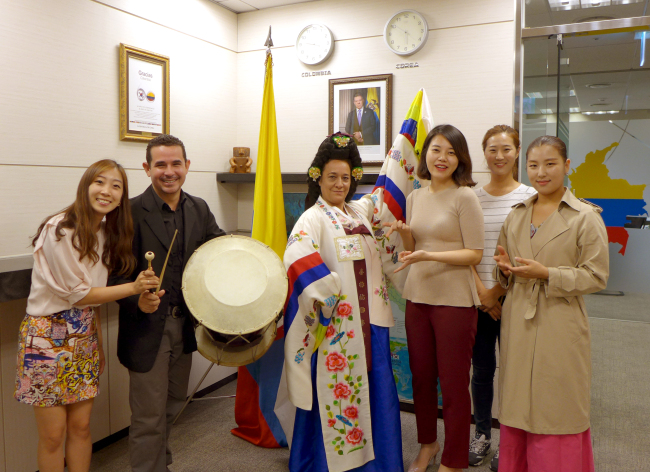A pair of Colombian traditional artists visited Korea in September to showcase the country’s carnival music and dance and engage in a cultural exchange with Korean artists.
Dancer and researcher Maribel Egea Garia and instrumentalist and professor Jarry Jose Julio Arjona came to Korea on Sept. 8 at the request of the Colombian Embassy, and performed at schools and events across the country.
They also took lessons on traditional Korean music and dance, provided by the Korean Classical Music Corporation.
Dancer and researcher Maribel Egea Garia and instrumentalist and professor Jarry Jose Julio Arjona came to Korea on Sept. 8 at the request of the Colombian Embassy, and performed at schools and events across the country.
They also took lessons on traditional Korean music and dance, provided by the Korean Classical Music Corporation.

Both are natives of Barranquilla, a city in northern Colombia by the Caribbean Sea that is famous for its carnival in February. The four-day festival is considered one of Latin America’s three major carnivals, along with those of Rio de Janeiro and Miami.
Declared a National Cultural Heritage by the Congress of Colombia in 2001 and recognized by UNESCO in 2003, the event has become a universal celebration by incorporating waves of cultural influences over the years.
“The carnival is a cultural melting pot, mixing the legacies of Spanish colonialists, their accompanying African slaves and South American natives,” Garia told The Korea Herald. “It passionately fuses the different elements, which manifest themselves in characteristic ways during the festivity.”
As various ethnicities and groups live harmoniously in Colombia, no apparent tensions or conflicts exist between them, Arjona said.
People prepare for the event for weeks or months on end, depending on their roles, he said, with the exception of few native tribes who live deep in the forests in the Sierra Nevada de Santa Marta region ― the Kogis, Arawakas and Wayuus. “They have the Colombian national identity in their heart, but been largely outliers to the event due to their culturally indigenous ways of life.”
According to Garia, the carnival originated from cultures surrounding the Caribbean Sea. The most famous dance is “la cumbia,” comprised of a pair of male and female dancers, where the man makes moves that resemble seducing his female partner, she said.
Arjona said that spectators can “indirectly” participate from the side of the road, singing and dancing, taking photographs and interacting with other crowds, but cannot jump into the carnival.
Barranquilla lies next to the Magdalena River delta facing the Caribbean, and has served as a strategic port for the riverside and maritime industries. It is now a main industrial, commercial, educational and cultural center in the Caribbean region of Colombia.
Tourists can participate in the carnival as part of a tour package that includes trips to nearby towns, or on an individual trip, Arjona added. The region has white sand beaches, lush green parks, cultural museums, traditional homes and centuries-old cathedrals.
The duo performed at the Korea National University of Arts, Korea National University of Education, Busan University of Foreign Studies, Busan International Travel Fair and Daejeon Foreign Language High School.
By Joel Lee (joel@heraldcorp.com)
-
Articles by Korea Herald



















![[Today’s K-pop] Treasure to publish magazine for debut anniversary](http://res.heraldm.com/phpwas/restmb_idxmake.php?idx=642&simg=/content/image/2024/07/26/20240726050551_0.jpg&u=)